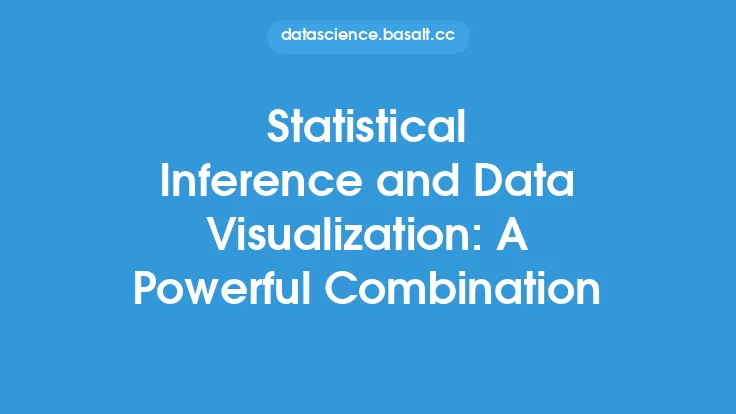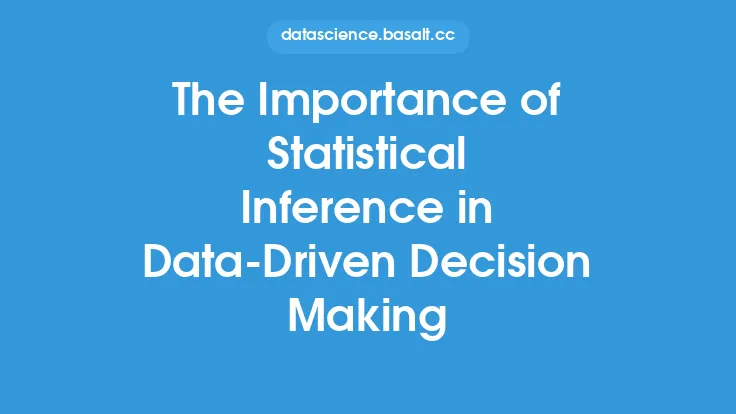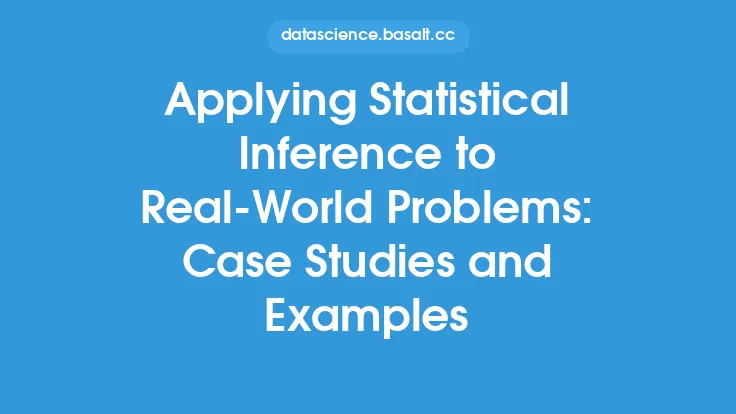Statistical inference is a crucial aspect of statistics that enables researchers and data analysts to draw conclusions about a population based on a sample of data. It is a bridge between data and insights, allowing us to make informed decisions and predictions about future outcomes. At its core, statistical inference involves using statistical methods to make inferences about a population parameter, such as the mean or proportion, based on a sample of data.
Introduction to Statistical Inference Concepts
Statistical inference relies on several key concepts, including probability, sampling distributions, and confidence intervals. Probability is a measure of the likelihood of an event occurring, and it plays a critical role in statistical inference. Sampling distributions, on the other hand, describe the distribution of a statistic, such as the sample mean, over repeated samples from the same population. Confidence intervals provide a range of values within which a population parameter is likely to lie, and they are commonly used to estimate population parameters.
Types of Statistical Inference
There are two main types of statistical inference: parametric and non-parametric. Parametric inference assumes that the data follows a specific distribution, such as the normal distribution, and it uses this assumption to make inferences about the population. Non-parametric inference, on the other hand, does not assume a specific distribution and instead uses methods such as permutation tests or bootstrap sampling to make inferences. Parametric inference is generally more powerful than non-parametric inference, but it requires that the data meet certain assumptions, such as normality and equal variance.
Hypothesis Testing
Hypothesis testing is a critical component of statistical inference, and it involves testing a null hypothesis against an alternative hypothesis. The null hypothesis typically states that there is no effect or no difference, while the alternative hypothesis states that there is an effect or a difference. For example, a researcher might test the null hypothesis that the mean score of a new treatment group is equal to the mean score of a control group against the alternative hypothesis that the mean score of the new treatment group is greater than the mean score of the control group. Hypothesis testing involves calculating a test statistic and determining the probability of obtaining that test statistic, or a more extreme test statistic, assuming that the null hypothesis is true.
Confidence Intervals
Confidence intervals provide a range of values within which a population parameter is likely to lie, and they are commonly used to estimate population parameters. A confidence interval is constructed by taking a sample of data and using the sample statistic, such as the sample mean, to estimate the population parameter. The confidence interval is then calculated using a formula that takes into account the sample size, the sample statistic, and the desired level of confidence. For example, a 95% confidence interval for the population mean might be constructed by taking a sample of 100 data points and using the sample mean to estimate the population mean. The confidence interval would then provide a range of values within which the population mean is likely to lie, such as 10.2 to 12.1.
Bayesian Inference
Bayesian inference is a type of statistical inference that uses Bayes' theorem to update the probability of a hypothesis based on new data. Bayes' theorem states that the posterior probability of a hypothesis is proportional to the prior probability of the hypothesis times the likelihood of the data given the hypothesis. Bayesian inference is commonly used in machine learning and artificial intelligence applications, where it is used to update the probability of a hypothesis based on new data. For example, a Bayesian inference model might be used to predict the probability of a customer purchasing a product based on their demographic characteristics and purchase history.
Common Statistical Inference Techniques
There are several common statistical inference techniques, including regression analysis, analysis of variance (ANOVA), and chi-squared tests. Regression analysis involves modeling the relationship between a dependent variable and one or more independent variables, and it is commonly used to predict continuous outcomes. ANOVA involves comparing the means of two or more groups, and it is commonly used to determine whether there are significant differences between groups. Chi-squared tests involve comparing the observed frequencies of categorical data to the expected frequencies, and they are commonly used to determine whether there are significant associations between categorical variables.
Assumptions of Statistical Inference
Statistical inference relies on several assumptions, including independence, normality, and equal variance. Independence assumes that the data points are independent of each other, and it is commonly violated in time series data or clustered data. Normality assumes that the data follows a normal distribution, and it is commonly violated in skewed or outliers data. Equal variance assumes that the variance of the data is equal across groups, and it is commonly violated in data with unequal variances. Violating these assumptions can lead to biased or incorrect results, and it is therefore important to check the assumptions of statistical inference before interpreting the results.
Limitations of Statistical Inference
Statistical inference has several limitations, including the risk of false positives and false negatives. False positives occur when a statistically significant result is obtained, but the result is due to chance rather than a real effect. False negatives occur when a statistically significant result is not obtained, but the result is due to a real effect rather than chance. Statistical inference is also limited by the quality of the data, and it is therefore important to ensure that the data is accurate, complete, and relevant to the research question. Additionally, statistical inference is limited by the sample size, and it is therefore important to ensure that the sample size is sufficient to detect statistically significant results.
Conclusion
Statistical inference is a powerful tool for making informed decisions and predictions about future outcomes. It relies on several key concepts, including probability, sampling distributions, and confidence intervals, and it involves using statistical methods to make inferences about a population parameter. There are several types of statistical inference, including parametric and non-parametric inference, and several common statistical inference techniques, including regression analysis, ANOVA, and chi-squared tests. However, statistical inference also has several limitations, including the risk of false positives and false negatives, and it is therefore important to carefully evaluate the results of statistical inference and to consider the assumptions and limitations of the analysis.





